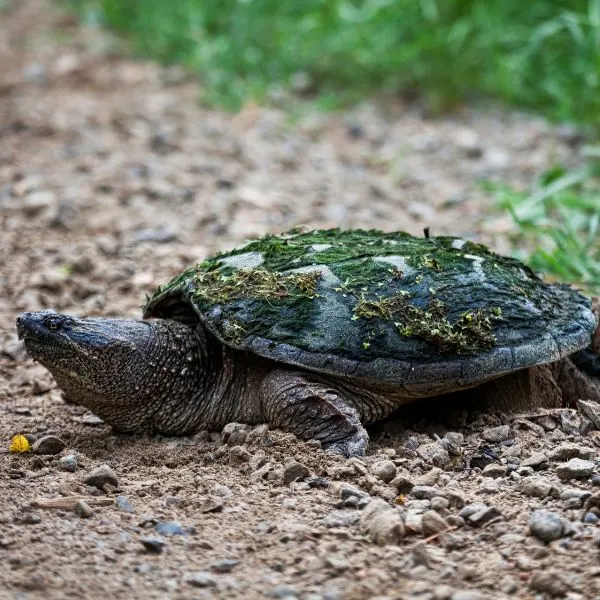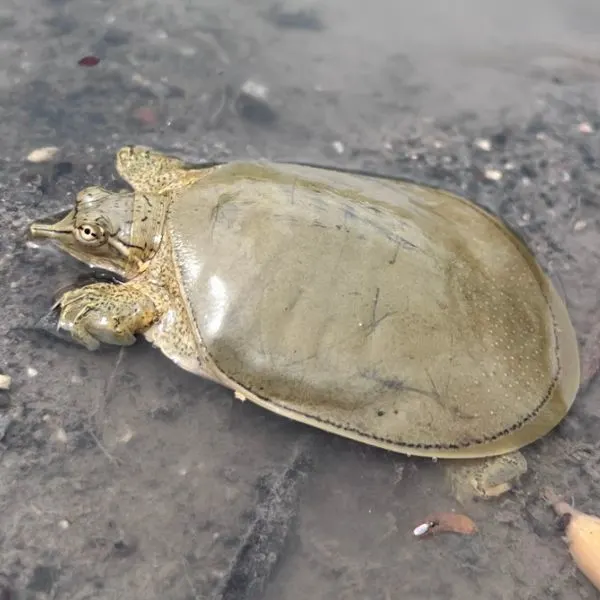Despite being the 13th largest US state, there are very few species of native turtles in Utah. There are three aquatic turtles living in Utah, they are the Painted turtle, the Common Snapping turtle, and the Spiny Softshell turtle.
There is one tortoise living in Utah as well. The Mojave Desert tortoise has been found in Utah, though its numbers are in decline in the state. Let’s take a look at the different types of turtles in Utah.
Table of Contents
Painted Turtles in Utah
1. Western Painted Turtle

- Experience Level: Beginner
- Family: Emydidae
- Scientific Name: Chrysemys Picta Belli
- Other Names: N/A
- Adult Size: Between 4 and 10 inches
- Lifespan: Between 30 and 50 years
- Average Price Range: Between $30 and $150
Western Painted turtles, the largest subspecies of the Painted turtle, have been spotted in Utah. At the moment, they are mainly confined to Kane County in the south of the state.
Painted turtles are common in many states across the nation and are a popular turtles to keep as pets as they are so easy going and easy to care for. They are distinguished by the bright yellow, orange, or red streaks of color on their heads, necks, and limbs.
Their skin is dark green, brown, or black, and they have dark shells with bright markings mostly along the edge. The plastron—the bottom section of their shell—is usually red or orange with black markings.
The Painted turtle prefers to stay in ponds, lakes, and other slow-moving bodies of water. They are great swimmers and spend a lot of time in the water, but they also love to bask in the warm sun.
Often painted turtles can be seen in large numbers together basking on logs, banks, or rocks. They will cover every inch of basking space and often climb on top of each other to reach the best spot.
These turtles are omnivorous and will eat vegetation, mollusks, frogs, tadpoles, fish, and other underwater invertebrates. They have to be submerged to swallow their food.
The Western painted turtle is listed as least concern in Utah. Meaning their numbers are healthy and their populations are steady.
Snapping Turtles in Utah
2. Common Snapping Turtle

- Experience level: Intermediate to Expert
- Family: Chelydrida
- Scientific Name: Chelydra Serpentina
- Common Name: Common Snapping Turtle, Snapper, Eastern Snapping Turtle
- Average Adult Size: 8 to 20 inches
- Life Span: 30 – 50 years
- Average Price Range: Approximately $40 to $120
Common Snapping turtles are large, heavy, freshwater turtles that are often thought of as water generalists. This big turtle can inhabit nearly any kind of water as long as there’s a soft, muddy bottom.
Snappers prefer a muddy bottom where they can hide and wait for food to come to them. When something edible gets near they strike out and snap it up.
They can be aggressive and will often hiss and bite, but they usually only display these behaviors when they are found outside of their watery domain. In the water, these gentle giants tend to hide or swim away from potential trouble. They spend so much time in the water that their shells are usually covered in algae.
This species of turtle rarely leaves the water. They can be seen basking occasionally, but they usually only swim to the surface of the water to warm up and then go back to their hiding places.
The other instance when they leave the water is for females to find a suitable nesting spot to lay their eggs. During these times, the snapping turtle can travel for miles. When they find soft, muddy ground to lay their eggs, they usually stay in that body of water.
Snapping turtles can easily be identified because of their hook shaped mouths, large bodies compared to their shell, and their exceptionally long tail. Other turtles found in Utah have very short tails.
Snapping turtles have thick shells, but they seem too small for the large turtle protruding out of them. Their heads and limbs bulge out from their carapace, the lower plastron hardly covers any of their body.
In Utah, Common Snapping turtles have been spotted in Washington county in the extreme southwest, mainly in the Virgin River area.
As nocturnal omnivores, Common Snapping turtles mainly eat fish, crayfish, frogs, and even other, smaller turtles. They aren’t picky and will eat anything they can fit in their sharp beaks.
Softshell Turtles in Utah
3. Texas Spiny Softshell Turtle

- Experience level: Intermediate to Expert
- Family: Trionychidae
- Scientific Name: Apalone spinifera emoryi
- Common Name: Spiny Softshell Turtle
- Average Adult Size: 5 – 17 inches
- Life Span: 40 – 60 years
- Average Price Range: Approximately $50 – 280
Texas Spiny Softshell turtles are a subspecies of the Spiny Softshell turtle. They have flattened, leathery pancake-like shells which feel like sandpaper. This turtle is called “spiny” because of the tubercles, or rough, small, lumps located on the front half of their shells.
They have pale rims around their shells, which distinguishes them from other subspecies. They have long, tapered beaks which they use to breathe while buried in the sand.
Because of their soft carapace and lack of protection, they can display aggressive tendencies. Softshells will hiss, claw, and bite when confronted. They have an unusually long necks that can strike out long distances and deliver flesh cutting bites.
Texas Spiny Softshell turtles are fast swimmers and quite speedy on land as well. They are mostly carnivorous and will feed on crustaceans, insects, and mollusks as well as the occasional plant. They bury themselves in the sand to ambush prey.
They are currently found in the Virgin River region of extreme southwestern counties and are listed as least concern.
Tortoises in Utah
4. Mojave Desert Tortoise

- Experience level: Beginner
- Family: Testudinidae
- Scientific Name: Gopherus agassizii
- Common Name: Mojave Desert Tortoise
- Average Adult Size: 9-15 inches
- Life Span: 50 – 80 years
- Average Price Range: Illegal to purchase a desert tortoise–Must be adopted
The Mojave Desert tortoise is native to the southwestern regions of Utah. They are threatened due to habitat loss and many other factors including illegal poaching, offroading, and slow mating habits.
Offroading vehicles are a big reason their numbers are declining. When people go offroading in the Utah hills, they can inadvertently run over these slow-moving tortoises.
People have also poached this tortoise from their natural habitat to sell for high profits. This has caused their numbers to decline so much that the government has made it illegal to sell or purchase them.
You can still adopt one if you really would like to keep one as a pet. Be aware though that these tortoises can live for up to 80 years.
Another reason they are in decline is because of their mating habits and predation on nests. It can take up to 15 years for a desert tortoise to reach sexual maturity, and then another 15 to 20 years before they reach their peak reproductive years.
When they lay eggs, the desert tortoise only lays small clutches of 6 to 10 eggs. Most of those that hatch don’t even make it to adulthood.
While adult tortoises don’t have natural predators, baby tortoises aren’t so lucky. Snakes, foxes, coyotes, and even ravens feed on the newly hatched turtles. They are so tiny, and their shells are soft when they are born, the baby tortoises don’t have a way to defend themselves.
Desert tortoises have large domed shells which range from brown to green, and pale, dusty looking skin and scales. This pale, bland coloring helps them blend into their dry habitat.
To survive the blistering heat of the Mojave desert where they live, these turtles will dig burrows and hide away to keep cool. The Mojave desert tortoise digs many burrows throughout its life. Many other animals such as owls, snakes, and some mammals use these abandoned burrows to live and rear young.
The Mojave Desert tortoise is an herbivore that mainly feeds on grasses, wildflowers, cacti, and succulents. They derive most of the necessary water requirements from the plants they eat. They also have specialized bladders that allow them to go up to a year without drinking if necessary.
Wrapping up
In this list, we’ve covered the four species of turtles found in Utah. The desert dwelling Mojave Desert tortoise, and three other aquatic turtles. The Western Painted turtle, the Common Snapping turtle, and the Texas Spiny Softshell turtle all call Utah home.
While the three aquatic turtles are thriving, the Mojave Desert tortoise is having trouble holding onto its claim. While there are efforts to sustain and protect the numbers of this tortoise, it’s going to take a long time to get their numbers up.
If you see these turtles in the wild, the best thing you can do is simply observe them from a distance. And if you’re driving around in the desert, keep an eye peeled for these slow-moving vegetarians.
Did you enjoy this list? Feel free to comment below and discuss these turtles with fellow herpetology enthusiasts!
Other nearby states
